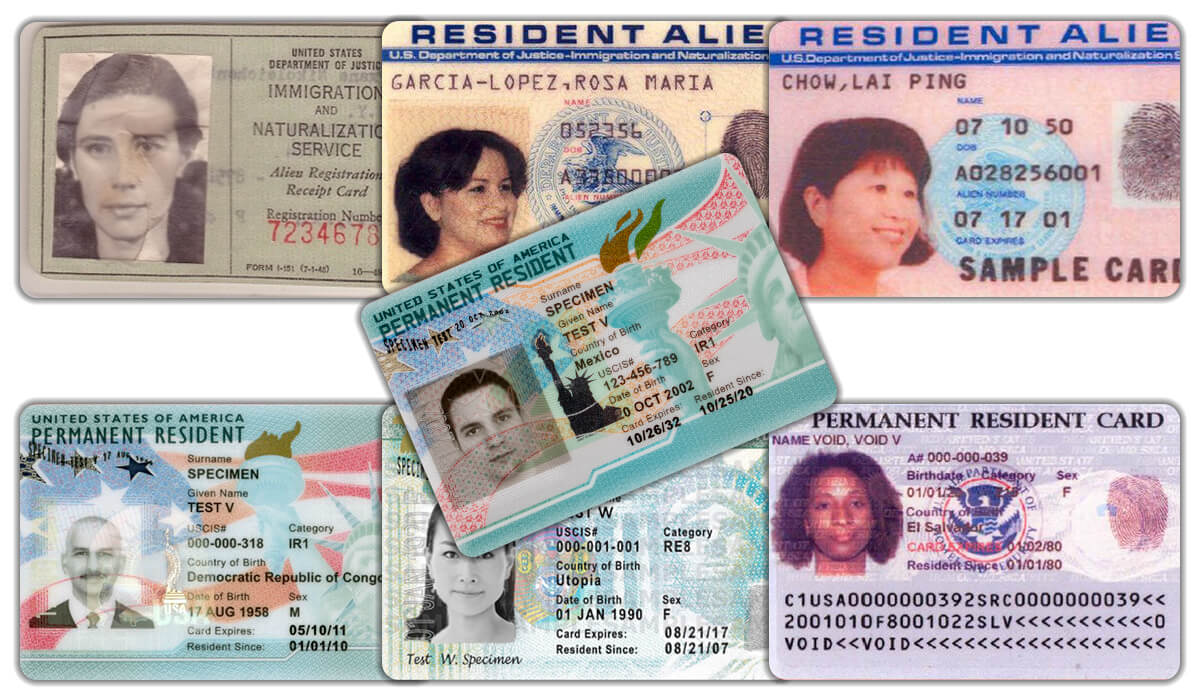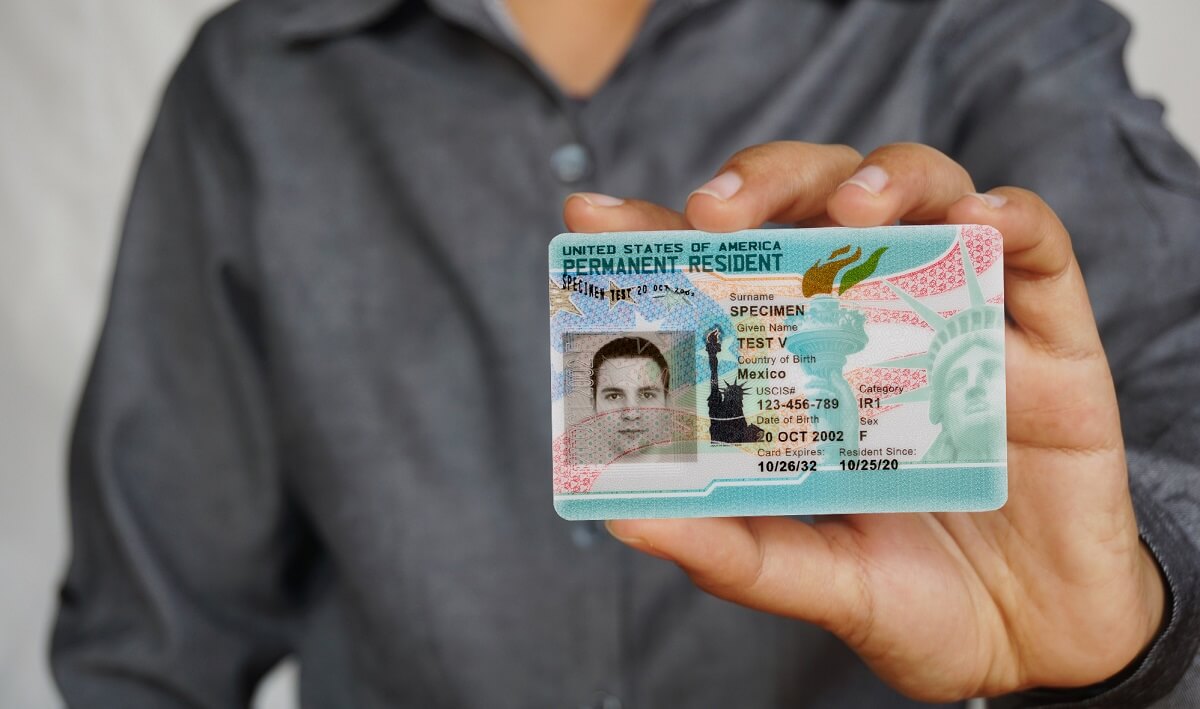
U.S. Immigration and Citizenship Services (USCIS) introduced the current version of the Permanent Resident Card, best known as a “green card,” in January 2023. In fact, USCIS redesigns the green card every few years to reduce the risk of fraud and counterfeiting. However, new card designs do not invalidate previous cards. The green card continues to be valid until the expiration date printed on the front of the card. USCIS has not significantly changed the modern green card in terms of the information displayed and how to read a green card.
How to Read the Front of a Green Card
Like its recent predecessors, the current green card utilizes some enhanced security features. State-of-the-art technology prevents counterfeiting, obstructs tampering, and facilitates quick and accurate authentication of the card. Some of the newest features include improved tactile printing, enhanced optically variable ink, highly-secure holographic images and more complex design elements.
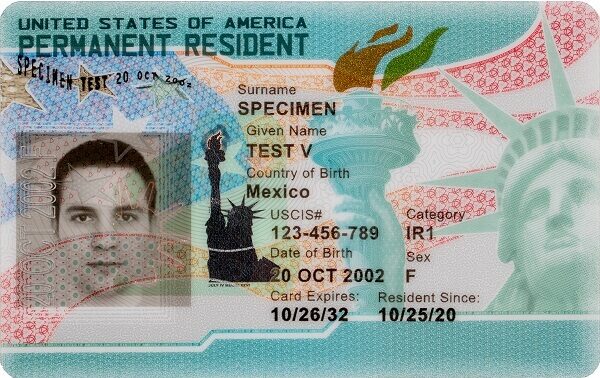
The front of a green card is mostly self-explanatory. It includes biographic information such as name, country of birth, birth date, sex, and card expiration date. Dates are generally in the MM/DD/YY format. USCIS removed the cardholder's fingerprint from the front of the card in 2023.
- USCIS# describes the cardholder’s alien registration number or “A-number.” All permanent residents have a unique 8- or 9-digit A-number.
- Category describes the immigrant visa category that was used to admit an immigrant to the U.S. as a permanent resident or conditional permanent resident. The field is also known as “class of admission” in other USCIS documents. The field is typically one or two letters followed by a number.
- Resident Since designates the date that a permanent resident was granted residence at a U.S. embassy or through adjustment of status at a USCIS office. It's an important date for permanent residents who intend to apply for citizenship through naturalization. It marks the beginning of the continuous residence requirement.
Not all green cards include the holder’s signature. In limited cases, USCIS waives the signature requirement for certain people, such as children under the age of consent or individuals who are physically unable to provide a signature. Since February 2015, USCIS has been waiving the signature requirement for people entering the United States for the first time as lawful permanent residents after obtaining an immigrant visa abroad from a U.S. embassy or consulate. Cards without a signature will say “Signature Waived” on the front and back of the card where a signature would normally be located.
Note: Green cards issued between 1979 and August 1989 do not have expiration dates and may not need to be renewed unless you want to use the Global Entry (GE) Program when traveling. GE kiosks cannot read the old format green cards. Although not required to replace these cards, USCIS does recommend replacement to reduce problems. Older photos, wear-and-tear, and unfamiliarity with these cards may cause some authorities to refuse them.
How to Read the Back of a Green Card
The back of a green card is a bit more cryptic and difficult to read. In fact, some of the micro images are so small, they might go unnoticed. Government agencies can quickly scan an optical stripe to gather all of the relevant card information.
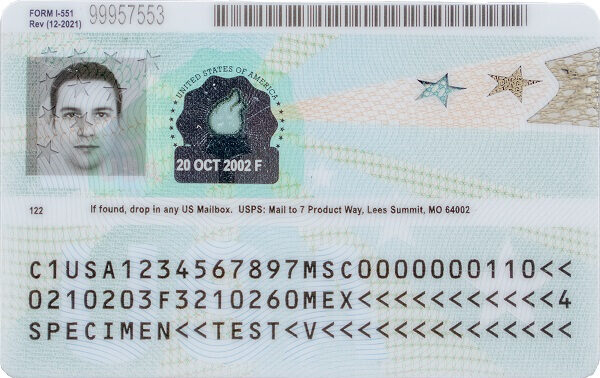
The top left corner includes a designation of "Form I-551." Form I-551 is synonymous with green card. It is the government's internal form number for the modern permanent residence document. The location of the form number may be different on previous versions of the card. Over time, the card has also been known as a Resident Alien Card or Alien Registration Receipt Card. These cards may be marked as "Form I-151" or "Form AR-3." Form I-151 and AR-3 are now obsolete. The cards are not valid, and cardholders should replace their cards using Form I-90, Application to Replace Permanent Resident Card.
In the bottom portion of the card there are human-readable characters that have meaning if you know how to read them. A line-by-line description is as follows:
First Line of Characters
- Characters 1–2: C1 or C2 (C1 = Resident within the United States C2= Permanent Resident commuter living in Canada or Mexico)
- Characters 3–5: Issuing country (USA)
- Characters 6–14: 9-digit number A-number
- Characters 15: Application receipt number
- Characters 16–30: Immigrant case number (first three letters represent service center code) and the "<" symbol represents a blank space
Second Line of Characters
- Characters 1-6: Birth date (in YY/MM/DD format)
- Characters 7: Not documented, possible check digit
- Characters 8: Gender
- Characters 9-14: Expiration date (in YY/MM/DD format)
- Characters 15: Not documented, possible check digit
- Characters 16-29: Country of birth
- Characters 30: Not documented, possible check digit
Third Line of Characters
Last name, first name, middle name, first initial of father, first initial of mother (this line is spaced with "<<" between the last name and first name). Depending on the length of the name, the father's and mother's initials may be omitted. For additional information about the newest version of the green card, see the USCIS press release.
Previous Versions of the Green Card
The two previous versions of the green card were very similar. However, they lack some of the current security features, use different artwork, and may have data fields displayed in different places.
2017 Version of the Green Card
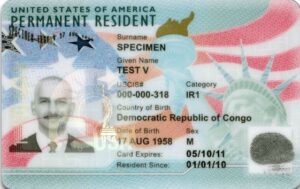
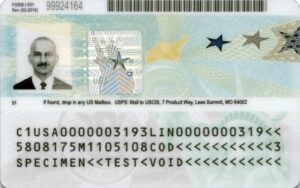
USCIS began issuing the prior version of the green card in May 2017. Because USCIS generally issues cards with a validity of 10 years, many of the cards are still in use. The card contains the bearer’s photo on the front and back, name, USCIS number (A-Number), date of birth, laser-engraved fingerprint, and card expiration date. This card does not have a signature or a black stripe on the back. Most of the data points are the same, but they may appear in different locations.
2010 Version of the Green Card
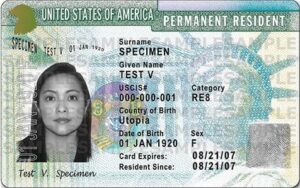

For many years prior to 2010, the permanent resident card was not actually green. In the 2010 version of the green card, USCIS returned to a green color for the card. The front contains the cardholder’s photo, name, USCIS number (A-Number), date of birth, laser-engraved fingerprint, and card expiration date. The USCIS (A-Number) is also located on the back of the card. These cards may or may not contain a signature.
Of course, over the history of the green card, designs and information have changed significantly. The scope of this article does not cover how to read a green card from these periods.
About CitizenPath
CitizenPath provides simple, affordable, step-by-step guidance through USCIS immigration applications. Individuals, attorneys and non-profits use the service on desktop or mobile device to prepare immigration forms accurately, avoiding costly delays. CitizenPath allows users to try the service for free and provides a 100% money-back guarantee that USCIS will approve the application or petition. We provide support for the Green Card Renewal/Replacement Package (Form I-90), Naturalization Application Package (Form N-400), and several other immigration services.
Want more immigration tips and how-to information for your family?
Sign up for CitizenPath’s FREE immigration newsletter and
SAVE 10%
on our immigration services



